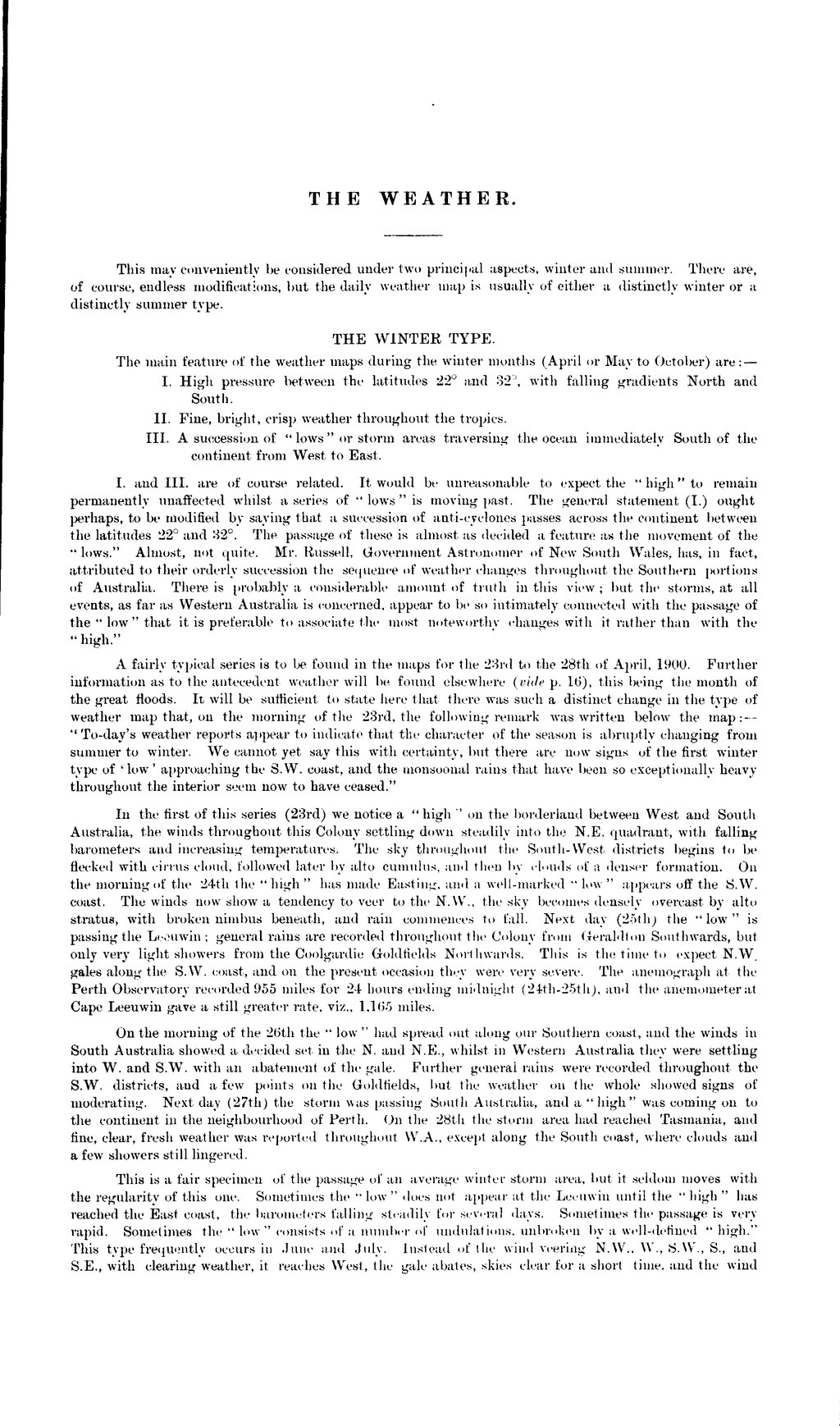THE WEATHER.
This may conveniently be considered under two principal aspects, winter and summer. There are, of course, endless modifications, but the daily weather map is usually of either a distinctly winter or a distinctly summer type.
THE WINTER TYPE.
The main feature of the weather maps during the winter months (April or May to October) are :—
| I. | High pressure between the latitudes 22° and 32°, with falling gradients North and South.
|
| II. | Fine, bright, crisp weather throughout the tropics.
|
| III. | A succession of "lows" or storm areas traversing the ocean immediately South of the continent from West to East.
|
I. and III. are of course related. It would be unreasonable to expect the "high" to remain permanently unaffected whilst a series of "lows" is moving past. The general statement (I.) ought perhaps, to be modified by saying that a succession of anti-cyclones passes across the continent between the latitudes 22° and 32°. The passage of these is almost as decided a feature as the movement of the "lows." Almost, not quite. Mr. Russell, Government Astronomer of New South Wales, has, in fact, attributed to their orderly succession the sequence of weather changes throughout the Southern portions of Australia. There is probably a considerable amount of truth in this view; but the storms, at all events, as far as Western Australia is concerned, appear to be so intimately connected with the passage of the "low" that it is preferable to associate the most noteworthy changes with it rather than with the "high."
A fairly typical series is to be found in the maps for the 23rd to the 28th of April, 1900. Further information as to the antecedent weather will be found elsewhere (vide p.16), this being the month of the great floods. It will be sufficient to state here that there was such a distinct change in the type of weather map that, on the morning of the 23rd, the following remark was written below the map:—"To-day's weather reports appear to indicate that the character of the season is abruptly changing from summer to winter. We cannot yet say this with certainty, but there are now signs of the first winter type of 'low' approaching the S.W. coast, and the monsoonal rains that have been so exceptionally heavy throughout the interior seem now to have ceased."
In the first of this series (23rd) we notice a "high" on the borderland between West and South Australia, the winds throughout this Colony settling down steadily into the N.E. quadrant, with falling barometers and increasing temperatures. The sky throughout the South-West districts begins to be flecked with cirrus cloud, followed later by alto cumulus, and then by clouds of a denser formation. On the morning of the 24th the "high" has made Easting, and a well-marked "low" appears off the S.W. coast. The winds now show a tendency to veer to the N.W., the sky becomes densely overcast by alto stratus, with broken nimbus beneath, and rain commences to fall. Next day (25th) the "low" is passing the Leeuwin; general rains are recorded throughout the Colony from Geraldton Southwards, but only very light showers from the Coolgardie Goldfields Northwards. This is the time to expect N.W. gales along the S.W. coast, and on the present occasion they were very severe. The anemograph at the Perth Observatory recorded 955 miles for 24 hours ending midnight (24th–25th), and the anemometer at Cape Leeuwin gave a still greater rate, viz., 1,165 miles.
On the morning of the 26th the "low" had spread out along our Southern coast, and the winds in South Australia showed a decided set in the N. and N.E., whilst in Western Australia they were settling into W. and S.W. with an abatement of the gale. Further general rains were recorded throughout the S.W. districts, and a few points on the Goldfields, but the weather on the whole showed signs of moderating. Next day (27th) the storm was passing South Australia, and a "high" was coming on to the continent in the neighbourhood of Perth. On the 28th the storm area had reached Tasmania, and fine, clear, fresh weather was reported throughout W.A., except along the South coast, where clouds and a few showers still lingered.
This is a fair specimen of the passage of an average winter storm area, but it seldom moves with the regularity of this one. Sometimes the "low" does not appear at the Leeuwin until the "high" has reached the East coast, the barometers falling steadily for several days. Sometimes the passage is very rapid. Sometimes the "low" consists of a number of undulations, unbroken by a well-defined "high." This type frequently occurs in June and July. Instead of the wind veering N.W., W., S.W., S., and S.E., with clearing weather, it reaches West, the gale abates, skies clear for a short time, and the wind
